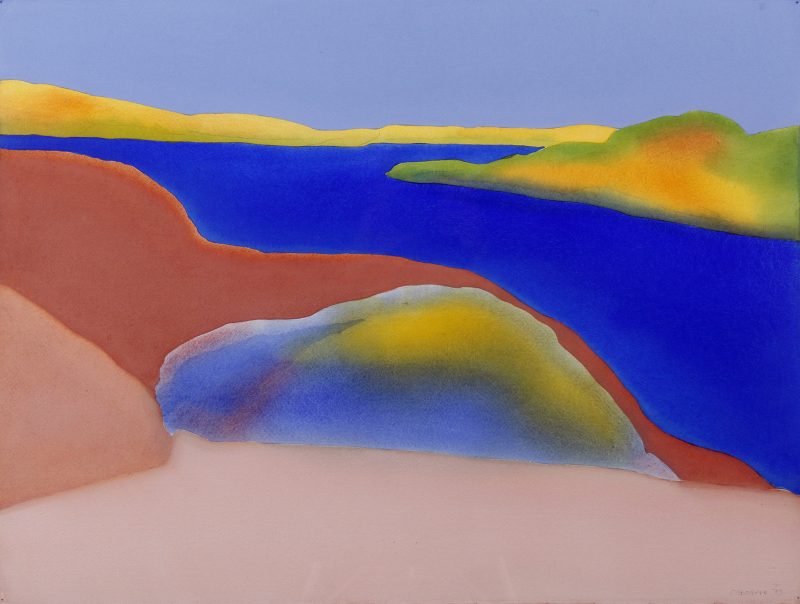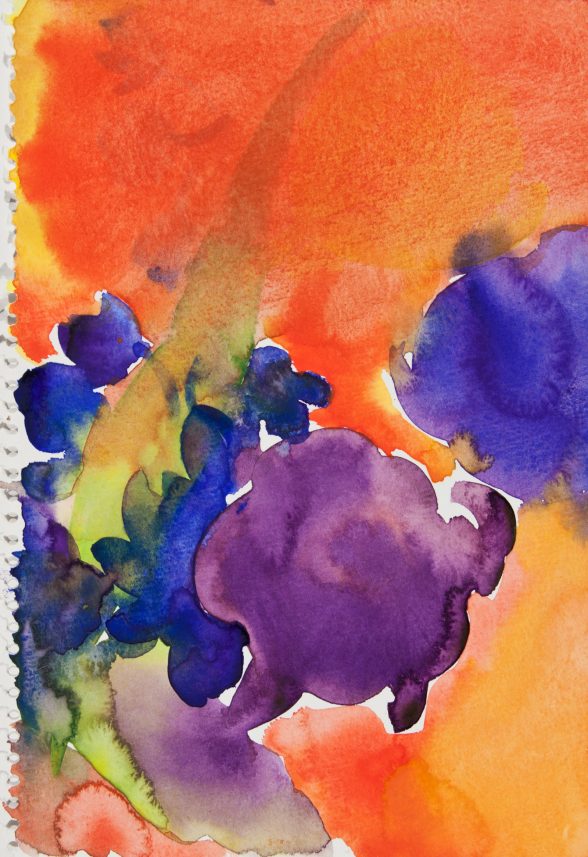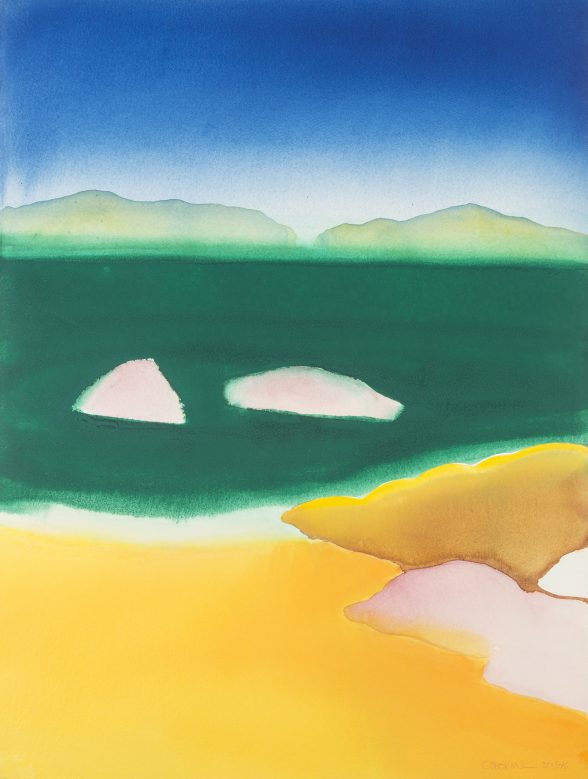
Tucked away in small gallery space on the third level at the Locks Gallery in Philadelphia are exquisite watercolors by Elizabeth Osborne. An acclaimed artist who lives in Philadelphia, Osborne is possibly at her very best in these color-drenched works on paper. These landscapes and floral works span the years between 1975 and 2016 and are truly jewels to behold. Adjacent to this space is a display of eight acrylic paintings, one dated 1965 from her early days as an instructor at PAFA.
Travel journals in watercolor to go to PAFA
During a recent conversation with Osborne, she informed me that more than thirty sketchbooks full of drawings and watercolors have been procured by the Pennsylvania Academy of Fine Arts. These treasures are readily accessible for public viewing on the 5th floor of the Hamilton Building.
I had the opportunity to peruse eight of the sketchbooks and I was not disappointed. There are certainly gems in these collection of small notebooks averaging 9”x 7.” The books ranged in dates from 1998 to 2014 and documented Osborne’s trips to Florida, Arizona, Mexico, Cape May, NJ, and her beloved sites in Massachusetts and Maine. Recently accessioned, the books were in random order. However, I tried to glean their chronology through the dates Osborne occasionally wrote in the lower section of finished works.

On the first page of the last book I studied was a singular red/orange hibiscus bloom with a cluster of leaves surrounding it. The detailed rendering of the flower with a blue halo wash floats within a delicate sea green background; evidently, it was an image recorded during a visit to Florida. Interspersed in the notebook were unfinished works of her trip to Mexico; these focused on architectural elements with one composition populated by the local vendors. The Mexico works segued to landscapes from Manchester that were more resolved, maybe because this region was very familiar to Osborne. It is an area of Massachusetts that she has visited for the last twenty years. A great discovery for me was to find a watercolor study for the seminal painting “Planets” (2009).
Osborne’s legacy at PAFA
Not only is Elizabeth Osborne a PAFA alum, she was also a professor at the Academy for more than forty years from 1963 to 2011. She was one of the first women to teach there, and served for many years as a faculty representative to the Board of Directors for the museum school. As the third woman to serve on the staff during the 1960s, she lobbied for faculty benefits and the hiring of printmaker Martie Zelt. She indicated during our conversation that the process to expand the faculty to include women was arduous.
Osborne states she never considered herself a feminist even though she came into maturity during the onset of the feminist movement in the US. She always considered herself an artist and gender did not play a significant role.
Although Osborne did not adhere to feminist precepts, she certainly very early in her career broke the mold in terms of color usage in her figurative and landscape works of the 1970s. She did so during a time when painters from the Philadelphia area, who trained at the Academy, were inclined to use local, neutral palettes and women were beginning to shape and enter the American arts mainstream in record numbers. Influenced by California painters such as Diebenkorn and Nathan Oliveira and the Washington color school painters, she opted for a brilliant color scheme, whether tackling the figure, or as evidenced in her more recent non-representational works.
Surviving and thriving in the gallery system
Osborne had a major presence in New York from the 70s to the early 90s. At first, she was represented by Gimpel & Weitzenhoffer Ltd. Gallery, and her dealer in the 1980s was Aladar Marberger of the Fischbach Gallery. Osborne has exhibited at Locks Gallery, now considered Philadelphia’s preeminent blue chip gallery, from its early years in the 1970s to the present.

Osborne’s survival in the gallery system garnered the support she needed to paint, particularly in the 1970s. She was fortunate to have gallery representation with established entities, while her counterparts were screaming for a greater presence especially in New York. (According to the research of Ferris Olin and Catherine C. Brawer, the percentage of solo gallery exhibits of work by women in major US cities ranged from 12-25% between 1970 and 1978, dropping to 19% by 1985). Alternative spaces were opening everywhere to help meet the demand for exhibition opportunities. Millennials are not the first generation to have a DIY approach when the commercial galleries and museums are not receptive to their work.
A painter’s life
Osborne’s number one priority in life is to paint. Even through a divorce and rearing her daughter for ten years as a single mom, she was a prolific painter. She painted her surroundings and the people in her life, views out of windows, still lives, and the landscapes of her travels and retreats.
A common thread that runs through Osborne’s entire oeuvre that spans more than fifty years is the level of control exerted in her paintings. Even when staining or using acrylics–and certainly in her watercolors–nothing is out of place, nor are there extraneous drips of paint or expressionistic mark-making. Each area or form holds its place juxtaposed against a sea of color and light. Marks and forms are deliberate and seem to be calculated exposés in solemnity.
From the 1970s to the 1990s, Osborne walked the tight walk between representation and abstraction, before she completely succumbed to non-representational work at the turn of the millennium. Recent works lean toward studies that explore the relationship to pure color and light. For years, Osborne spent months along the bank of Manchester by the Sea in Massachusetts and later near Lincolnville and Somes Sound, Maine. Her plein air studies were fodder for innumerable watercolors; maybe these experiences with nature and natural light feed her rendezvous with color. Sunlight itself plays games with the eye, taking into consideration the changes an object undergoes depending on the time of day. Osborne captures its brilliance whether in paintings of tranquil landscapes or in abstract works that exude an inner radiance.
Osborne is as tenacious and determined as she ever was. She has lived long enough to see many trends go in and out of fashion in painting and the art world in general. However, her dedication to her own vision has been consistent and a deliberate journey. Her works are like extensions of a long meditation, revealing an inner world of calm.









